Serum Mir‐22 Prognostic Marker Explored for Acute Myeloid Leukemia
By LabMedica International staff writers
Posted on 25 Jun 2020
Acute myeloid leukemia (AML) is an aggressive hematopoietic stem cell malignancy that is characterized by the clonal proliferation of myeloid precursors. Abnormal accumulation of leukemic blasts in the bone marrow, blood, and other tissues results in significant reductions of normal blood cells.Posted on 25 Jun 2020
MicroRNAs (miRNAs) are small (19‐25 nucleotide), noncoding RNAs that control the gene expression at the post‐transcriptional level, leading to target mRNAs degradation or translational inhibition. Increasing evidence has demonstrated that miRNA dysregulation is associated with the initiation and progression of cancer.

Image: The NanoDrop 2000 and 2000c are full-spectrum, UV-Vis spectrophotometers used to quantify and assess purity of DNA, RNA, Protein and more (Photo courtesy of Thermo Fisher Scientific).
Scientists at the Panyu Central Hospital (Guangzhou, China) enrolled a total of 124 patients with newly diagnosed AML and 60 healthy individuals as controls in a study. Serum samples were collected and stored. Total RNA was isolated from serum with the miRNeasy Serum/Plasma kit (Qiagen, Hilden, Germany). The RNA concentration was measured with a NanoDrop 2000 spectrophotometer (Thermo Fisher Scientific, Waltham, MA, USA).
Cel‐miR‐39 was used as the spiked‐in control. The cDNA was reverse‐transcribed from total RNA using the TaqMan MicroRNA Reverse Transcription Kit (Applied Biosystems, Foster City, CA, USA). The amplification of cDNAs was performed on the Applied Biosystems 7500 Real‐Time PCR system. The relative serum miR‐22 expression levels were normalized to cel‐miR‐39 and calculated by the 2–ΔΔC t method.
The investigators reported that the serum miR‐22 expression was significantly downregulated in AML subjects compared to healthy controls. Serum miR‐22 levels were lowest in AML patients with M4/M5 subtypes, and low serum miR‐22 expression occurred more frequently in AML patients with higher white blood cell counts or poor cytogenetic risk. Receiver operating characteristic (ROC) analysis revealed that serum miR‐22 well differentiated AML cases from healthy controls. In addition, serum miR‐22 downregulation was closely associated with worse clinical features and shorter survival. Low serum miR‐22 expression was confirmed to be an independent predictor for overall survival and relapse‐free survival in AML patients. Moreover, the expression level of serum miR‐22 was dramatically increased following treatment. In addition, serum miR‐22 levels were significantly higher in AML patients achieving complete remission (CR) than those without CR.
The authors concluded they had demonstrated that the serum miR‐22 expression is markedly downregulated in AML. In addition, downregulation of serum miR‐22 is significantly associated with aggressive clinical variables and poor prognosis of AML. Therefore, serum miR‐22 might serve as a promising prognostic biomarker for AML. The study was published on June 12, 2020 in the Journal of Clinical Laboratory Analysis.













